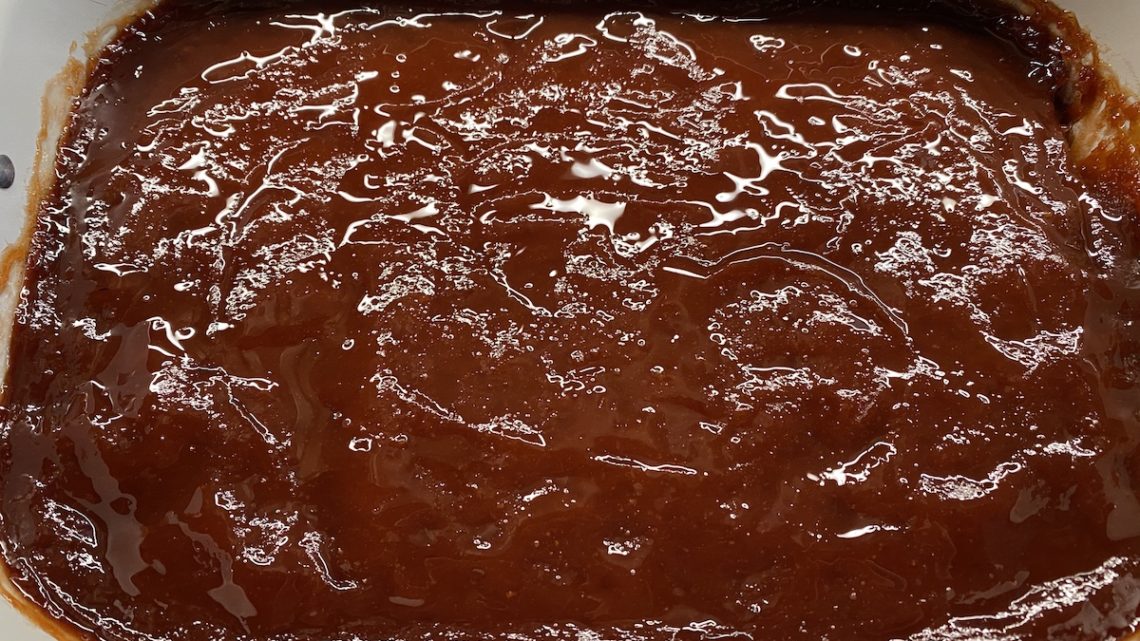membrillo
Ingredients
2kg quince, peeled, cored and roughly chopped
1 lemon juiced and zest pared (use a vegetable peeler)
about 1½ kg sugar
knob of butter
Method
- Put the quinces and lemon zest and juice in a large heavy-based pan. Add enough water to cover the fruit. Bring to the boil, then reduce the heat and simmer for about 1 hr until the quinces are very tender. Strain through a jelly bag or muslin-lined colander. Do not press out the juice – just leave it for at least 4 hrs, or ideally overnight, until the juice has dripped through.
- To make the jelly, put three saucers in the freezer. Measure the juice and return it to the pan (reserve the leftover fruit for the membrillo paste). For each 1 litre juice, add 750g sugar (or for each 100ml juice, add 75g sugar). Bring to the boil, stirring to dissolve the sugar, then boil hard until set. This could take between 5 and 20 mins. To test for set, spoon a little onto a chilled saucer, leave for 1 min, then push your finger through the juice. If it wrinkles, the jelly is set. If not, return to the heat and boil again for a few mins, then test again.
- Remove from the heat and skim off any surface scum with a slotted spoon. Stir in the butter to dissolve any leftover sediment, then stir in the rose water. Pot into sterilised jars, seal and label. Store in a cool, dry place for up to one year.
- To make the membrillo, line a 16 x 24cm shallow oblong tin or tray with baking parchment. Tip the reserved fruit into a food processor and whizz to make a smooth-ish paste. Weigh the paste and for each 1kg paste, add 750g sugar (or for each 100g paste, add 75g sugar).
- Tip the paste and sugar into a large heavy-based pan and heat gently, stirring to dissolve the sugar. Increase the heat and cook, stirring regularly, for 30-45 mins until the paste is thick and golden, and leaves a gap when you run a wooden spoon across the base of the pan. Be careful as the mixture will spit at you and can burn. Spoon into the tin or tray and smooth the top. Leave to cool, then chill overnight until it is very firm.
- Wrap the paste in fresh baking parchment, then over-wrap in foil and store in the fridge for up to 6 weeks.
Pannetone Bread Pudding
The best way to use Pannetone over the festive season. Be sure to buy an organic brand if you are able to find it.
Ingredients
125 g unsalted butter, plus extra for greasing
4 tablespoons demarara sugar
750 g panettone
1 vanilla pod
300 ml of double cream
300 ml whole milk
5 large free-range eggs
100 g caster sugar
Method
Preheat the oven to 180 ° C. Lightly grease an oven-proof dish with butter. Coat the dish with 2 tablespoons demarara sugar.
Thinly cut off the edges of the panettone and use them to coat the base and sides of the dish, press down firmly to create a pastry-like base.
Halve the vanilla pods lengthwise and scrape the seeds out, then put the seeds and the pod in a pan over a medium heat with the cream, milk and butter and simmer for 5 minutes or until the butter has melted.
In the meantime, whisk the eggs and caster sugar in a large bowl for 2 minutes until smooth. Add the warm cream mixture to the bowl and whisk until combined. Discard the vanilla pod.
Pour a third of the egg mixture into the bottom of the cake and let it soak in for a few minutes.
Tear all remaining panettone into large pieces, leave them for a minute or two in the custard (the more it soaks up, the better!), then place it in to the oven dish. There is no need to be neat about it, you want a both soft and crispy pieces..
Pour over the remaining custard, soak a little longer if you want and sprinkle with the remaining demarara sugar.
Bake for about 25 minutes, or until set. Let the pudding rest for 10 minutes and then serve with cream, custard or ice cream if you want - it is also delicious served cold!


